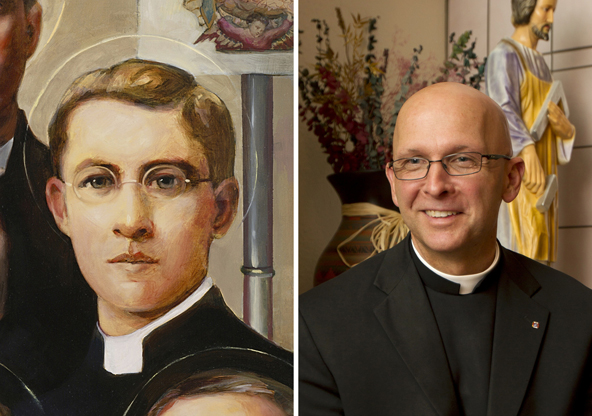
GALLUP, N.M. (CNS) — When the Gallup Diocese acquired a first-class relic of a martyred saint of the Mexican Cristero Rebellion, Bishop James S. Wall knew it was a spiritual intervention.
In April, the diocese received a relic from the body of St. Jose Maria de Robles Hurtado, a priest martyred in 1927 in Jalisco, Mexico, during the Cristero Rebellion.
One of 25 Cristero martyrs canonized by Pope John II in May 2000, St. Jose is known as “The Madman of the Sacred Heart,” because he promoted greater devotion to the Sacred Heart of Jesus through his preaching, his personal example and his great devotion to the Eucharist.
That connection could not be more appropriate for the diocese, Bishop Wall said.
“Our cathedral is named after the Sacred Heart,” he said. “There’s a reason why we got this special gift.”
The relic was a gift from Cardinal Jose Francisco Robles Ortega of Guadalajara, Mexico. Bishop Wall had it placed in a marble plate inserted in the altar of his private chapel to be venerated each time he says Mass there.
“I come in to pray here around 5:15 a.m. every day seeking the intercession of St. Jose,” Bishop Wall said. “He had the courage to proclaim the light of the Gospel, which is so important in the world that has been darkened by secularism.”
Some months before the cardinal’s gift arrived, Bishop Wall began working with the Gallup Knights of Columbus to try to locate a relic from one of the Cristero martyrs, many of whom were Knights. The bishop himself is a fourth-degree Knight.
Work began with the Knights officials at the organization’s headquarters in Connecticut. Ten months later, the diocesan officials learned they would receive the relic from St. Jose, who was hanged after being found saying Mass in the home of a family who was hiding him.
But you could say the quest for such a relic began after Bishop Wall’s installation in Gallup three years ago. He began renovation on the chapel in his private residence, using a Southwest decor of soft plastered walls, terra cotta ceramic tile floors and viga beams on the ceiling. The wood facade surrounding the small altar is adorned with stained-glass images of saints and the Holy Family.
But something was missing.
Bishop Wall said that missing link came to him through the Holy Spirit while he was celebrating Mass during Lent in 2011.
“The Sacred Heart image came to me during the consecration,” he said. “It was prompted by the Holy Spirit that I needed that image there.”
An image of the Sacred Heart of Jesus was painted below the altar, but Bishop Wall felt one last finishing touch was needed, thus came the search for a relic.
As a history major while attending Arizona State University, Bishop Wall became enthralled with the Cristero Rebellion of the 1920s, which saw Catholic clergy and laity taking up arms to oppose the Mexican government’s systematic repression of the church and to defend religious freedom. Thousands died in defense of the church in Mexico before the uprising was quelled in 1929.
“It is fascinating to think that less than 100 years ago in a country predominately Catholic, the church was essentially outlawed,” Bishop Wall said.
Not unlike the ignorance that fueled the religious laws of the Mexican Constitution of 1917, which ultimately led to the rebellion, the bishop said the church continues to face assaults from secularism and political policies that promote abortion, birth control and same-sex marriage.
Bishop Wall said he also shares the message of strong faith he feels the relic exudes with the people of his diocese, which was once part of Mexico.
He said so many martyrs were ordinary people. It isn’t until they are called upon to defend the teachings of the church, he said, that they are called to a higher order, such as the Cristeros, that all are capable of achieving.
Gallup, which is one of the nation’s poorest Catholic dioceses, straddles northwestern New Mexico and northeastern Arizona. It covers more than 55,000 square miles, serves close to 62,000 Catholics out of a total population of about 495,000.
— By Joseph J. Kolb, Catholic News Service






